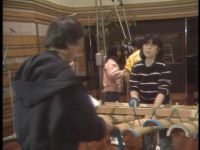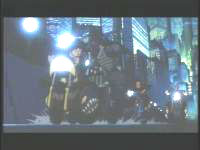

Quick Links:
Symphonic Suite Akira
In his review for the soundtrack album to the movie Neko no Ongaeshi, my colleague Angelo noted that there are two schools of thought in evaluating music: those who seek a new direction, and those who seek a foundation in the classics. While the Neko no Ongaeshi soundtrack may be popular with the classical foundationists, the Symphonic Suite Akira will definitely please those seeking a new direction in music. In fact, I must say that I have never heard anything quite like it before.
The music itself is composed by Shoji Yamashiro, the leader of the musical group Geinoh Yamashirogumi (which roughly translates as "The Yamashiro Art Group"), and is an interesting mix of synthesizers, human voices, and Balinese percussion instruments. Yes, you read that right; the Akira soundtrack is quite possibly the first true piece of "world" music in an anime soundtrack. The sound is an interesting mix of polar opposites; you can't get more un-natural than an electronic synthesizer, and you can't get more natural than human voices. Throw in the percussion instruments, some made of metal, and some made of wood, and you have a truly unique sound.
One big thing that separates the Symphonic Suite Akira from other anime soundtracks is the fact that the creation of the music preceded the creation of the actual film. Shoji Yamashiro was tasked with creating songs with a specific "ancient/future" sound, but no other boundaries were given. In fact, at times the film was molded to fit the music, rather than the other way around. Because of this, this album has a thematic unity that is often lacking in other soundtracks, because none of the music had to be sacrificed due to limitations inherent to the film. In order to keep this approach from making it unduly difficult to utilize the music in the film, the music features a number of repeating musical patterns. This allowed the film makers to easily sample out specific segments of songs, when needed, to fit shorter scenes in the film. In fact, four of the tracks on this album are over 10 minutes in length, which would have made the music unusable if not for the use of this "sound interspace" method.
The actual sounds used in making the album are pretty earthy. The use of synthesizers does make for some odd juxtapositions when overlaid on the acoustic percussion or choral singing, but for a significant part of the album you are dealing with wooden percussion instruments and human voices. Even though the album makes use of musical styles from around the globe, there is still a Japanese influence evident in the music. In fact, the song Illusion is based around the themes of a Noh performance. There are a couple exceptions to this trend, such as the eighth track, Exodus from the Underground Fortress, which actually uses electric guitar and synthesizer as the basis for the sound, but for the most part the music on this album is based on traditional acoustic sounds from around the world.
If you have an ear for well-crafted music, you can tell upon listening to this album that the music is put together very well. All of the elements of the music fit together quite well and form a surprisingly cohesive whole when you listen to the entire album from start to finish. This doesn't mean that you will like the album, however. In fact, the first time I listened to this album, I couldn't figure out why anyone would ever listen to such a thing. It was just so different from the kind of music I traditionally listen to. And let's be serious with ourselves; how many times are you going to want to hear a musical track based around heavy breathing? (That would be track two, Battle Against the Clown, if you don't believe me.) The music also contains a certain menace to it at times, which can be a little unsettling. If you've seen the film, you will realize that this is totally fitting with the overall themes presented in the movie. That doesn't mean it is always fun to listen to, however.
Once I gave it a chance (I had to; I was reviewing the album!), though, the excellent craftsmanship evident in the music began to shine through. Additionally, once I got used to the unexpected sounds and rhythms in the music, it didn't seem near as bizarre as it first did. I can't say that this album will ever be in heavy rotation in my CD player, but it won't be banished to the storage bin, either. I'll probably never listen to the track Illusion again, though. If you like the film, then you may very well enjoy this CD. If you have an open mind and can appreciate different styles of music that can challenge your perceptions of what music should be, then you may very well enjoy this CD. If you can't break out of top 40 pop music, then you may very well hate this CD.
To the best of my knowledge, this is actually the third Akira soundtrack release to grace Western shores. JVC released the soundtrack first in 1990, under the title Akira Original Soundtrack. Then in 2001, the AnimeTrax label re-released the album. Now, in 2004, Geneon has re-released the same album yet again. The actual music on the CDs is the same; what is different is the CD booklet. The JVC and AnimeTrax discs come with shorter booklets than the new Geneon release, which is based on the original Japanese release of the album. It's actually quite a lengthy little booklet, including a brief history of the group Geinoh Yamashirogumi, a discussion of Akira's music by none other than the original manga author Katsuhiro Otomo, an article by group leader Shoji Yamashiro about making the music on the album, commentary for every track, translated and romanized lyrics to the songs with actual words, and an article about the "Sound Interspace" method of composing used in the music. It's quite a lot. Unfortunately, the translation from Japanese to English is quite literal, which gives some of the articles a stilted feel. This makes some of the articles hard to read, but if you really care about the music, you'll be able to fight through it and get a lot of neat background around the music's creation. Oh, there are also two temporary tattoos of the Akira logo stuck in the booklet, for those of you who enjoy such things.
So, in the end, this is an interesting album that might have a hard time finding an audience. It has such a unique sound that it defies categorization. I can't promise that you'll enjoy it, but if you have a chance to listen to it then I would recommend giving it a chance, if just to add some variety to your musical experiences.







